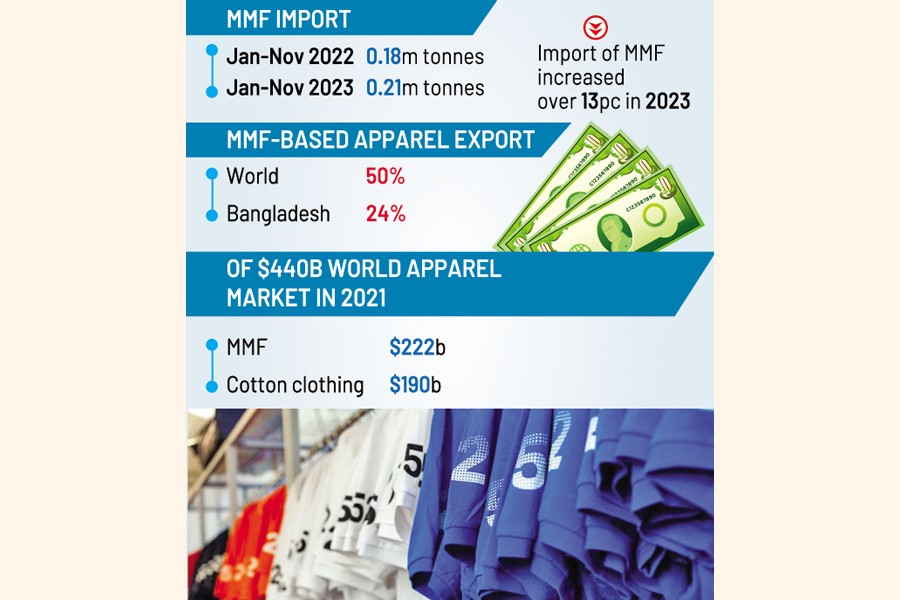
Manmade-fibre imports by Bangladeshi apparel exporters are on the rise, indicating an increased use of non-cotton in diversified garment manufacturing to grab larger slice of booming global market of such new wear.
Industry sources said imports of the classy non-cotton fibre increased over 13 per cent in the past calendar year, in the exporters' bid to catch up with the fast-going transition in the world clothing demand.
In a faster transition, in the year 2021, the global apparel-market size was $440 billion with MMF-based apparel market expanding to $222 billion or 51 per cent and cotton-based $190 billion or 42 per cent, a research in the taste change showed.
Bangladesh imported 0.21 million tonnes of polyester and viscose fibres during January- November period of 2023, according to Bangladesh Textile Mills Association (BTMA) data.
The import was 13.39-percent higher than the 0.18 million tonnes bought in during the corresponding period of 2022, data showed.
According to industry people, Bangladesh largely manufactures cotton- based garment as 75 per cent of the readymade garments shipped for export are made from cotton.
But, in recent times, the use of non-cotton or manmade fibres has been on the increase though the percentage has yet to reach satisfactory level, they said, and sought government policy supports.
Asked about the switch, Bangladesh Knitwear Manufacturers and Exporters Association (BKMEA) vice-president Fazlee Ehsan Shamim said the MMF imports increased in recent times in an indication of the increasing use of non-cotton fibre.
"It means we are producing both new products and value-added items," he said, adding that the global demand for such items has been increasing over the years.
Mr Shamim, however, feels that they need 'supportive' policy measures, especially those of customs-related, to encourage entrepreneurs to go for such non-cotton segments and attract investment.
Bangladesh Garment Manufacturers and Exporters Association (BGMEA) president Faruque Hassan recently said their vision is to reach US$100 billion worth of export by 2030.
"To achieve that level diversification of products, fibers and market are our key priorities," he added.
In recent years, he said, they made significant investments in high- value-added segments like active wear, outwear, denim, lingerie, suits, fancy dresses and formal wear.
BGMEA is also working to develop luxury dresses for ladies using centuries-old heritage material jamdani and muslin fabrics while the trade body is also focusing on efficiency enhancement and capacity development in terms of new product development and innovation, efficiency and profession skills enhancement and building more tech-savvy industry.
The trade body of garment manufacturers and exporters on different occasions demanded 10-percent cash incentives for MMF-based garment manufacturing.
Production of MMF items requires huge investment in backward linkage and there are hardly few ones who want to invest amid absence of required infrastructures, including sufficient gas supply, an exporter said.
The exporters feel that government policy support is imperative to attract investment in production of man-made fibre-based garments - not only to increase value addition but also to face the post-graduation challenges and remain competitive.
The sector leaders requested the government to extend requisite policy supports, including incentives, for non-cotton or man-made fibre production and effective measures to develop expertise in the segment and technology transfer.
According to a research by Research and Policy Integration for Development (RAPID) in 2022, Bangladesh could earn US$95 billion by 2030 from readymade garment (RMG) export if the country can raise its MMF-based garment shipments alongside the existing cotton-made clothing items.
Bangladesh would need to achieve 12 per cent and 20 per cent of the global MMF and cotton-based items' market share respectively for the aspired amount of export.
The country captures less than 5.0-percent and 16-percent market share of the global MMF-based and cotton-based apparel respectively, according to the research findings.
At present, almost half the total global apparel exports are MMF products while 42 per cent are cotton-based.
In contrast, majority or over 72 per cent of Bangladesh's garment exports are cotton-based, while only 24 per cent are MMF.
In a faster transition, in the year 2021, the global apparel-market size was $440 billion, of which MMF-based apparel market was $222 billion or 51 per cent, and cotton-based $190 billion or 42 per cent, it showed.
© 2024 - All Rights with The Financial Express
